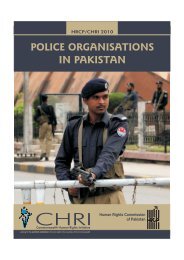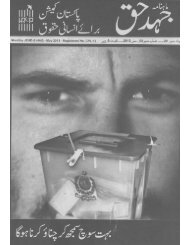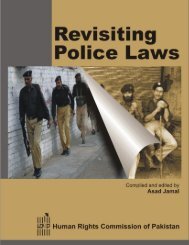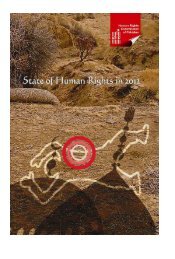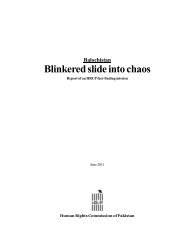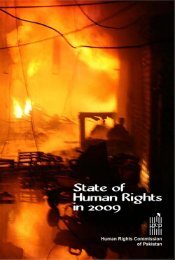Download PDF file - HRCP
Download PDF file - HRCP
Download PDF file - HRCP
You also want an ePaper? Increase the reach of your titles
YUMPU automatically turns print PDFs into web optimized ePapers that Google loves.
<strong>HRCP</strong> fact-finding missions’ report 45<br />
government dominated by Punjabi leadership amalgamated all four provinces of West Pakistan into one single<br />
unit in 1955. This political decision marginalized smaller provinces and undermined minority ethnic identities. 29<br />
After a few years of conflict, the central government took control of the province. An amnesty was declared<br />
but when the Baloch leaders came down from the mountains, they were caught and hanged. This betrayal has<br />
left bitter memories and deepened the mistrust between the Central government and the Baloch nationalists.<br />
Alow-level of insurgency continued, and once again intensified in 1964-65, breaking into an armed<br />
conflict between the military and Baloch nationalists.. The number of fatalities and casualties are not documented,<br />
but independent sources say that at least 2000 people including military personnel lost their lives.<br />
In 1972, Balochistan had its first elected provincial government and many Baloch members blessed<br />
the new Constitution. Soon afterwards, the government of Zulfikar Ali Bhutto dismissed the provincial legislature<br />
of Balochistan after accusing the ruling party of being involved in transporting Soviet arms to Balochistan. The<br />
Bhutto government claimed that these arms were discovered in Islamabad and were destined for Balochistan.<br />
The leadership of National Awami Party (the ruling party in the province) was arrested. Baloch nationalists<br />
reacted strongly. The main leaders amongst these were the Marri and Mengal tribesmen led by Khair Bux<br />
Marri and Sardar Ataullah Khan Mengal. Many of them took up arms and fled to the mountains. In September<br />
of 1974, the government sent 80,000 troops to put down the insurgency. It is reported that at least 3,000<br />
people lost their lives. There are, however, no official figures available. It is widely acknowledged that<br />
^discriminate use of superior force including air power was used against Baloch camps and villages.<br />
After the suppression of the revolt, the two Baloch leaders went into exile. Marri went to Afghanistan<br />
and Mengal to the United Kingdom only to return years later. During this period the name of the Balochistan<br />
Liberation Army (BLA) cropped up. They were accused of being behind the insurgency which lingered on into<br />
the 1980s. The BLA is reported to have been a pro-Moscow underground militant group, but faded away<br />
from public view after the disintegration of the Soviet Union. There are some unconfirmed reports that their<br />
initial recruits were drawn from the Baloch Student Organisation (BSO), but the present BSO denies any<br />
connection to BLA.<br />
In recent years, the BLA has surfaced again and seems to have swelled its support. It has claimed<br />
responsibility for a number of acts of violence. Their identity is, however, unknown. Official sources allege that<br />
they operate throughout Balochistan but also admit that they have no firm knowledge of its structure andshape.<br />
The new crisis<br />
A simmering insurgency has continued in Balochistan over the last three decades, but, since the early<br />
1970s, there has been no open armed conflict between the government and the Baloch tribes. There were<br />
press reports of tensions followed by consultations and meetings between leaders of the ruling party and<br />
Nawab Akbar Bugti. Former prime minister Mir Zafarullah Jamali visited the Nawab in Dera Bugti. Baiochistan’s<br />
Chief Minister publicly acknowledged the need to consult the Nawab. 30 In early 2000, tensions rose but by in<br />
the beginning of 2005, it boiled over. Some key incidents appear to have flared tempers leading to the present<br />
crisis. Since incidents of violence against the Baloch have been poorly reported, they are not traced here with<br />
any precision. These tensions can broadly be traced to the following incidents:<br />
♦ On January 7 ,h , 2000, the gunning down of a judge of the Balochistan High Court, Justice<br />
Nawaz Marri and subsequent arrest of Nawab Khair Baksh Marri on charges of having authored the crime.<br />
The judge was shot dead by unknown assailants. The Nawab was released in July 2001, after remaining in<br />
prison for 18 months. A team of <strong>HRCP</strong> members visited him in Querta jail and confirmed that he was kept in<br />
solitary confinement. He was disoriented and extremely bitter when the <strong>HRCP</strong> representatives met him.<br />
♦ Soon after the arrest of Nawab Marri, the BLA re-emerged. Their identity is unknown but the<br />
organization has claimed responsibility for a number of bomb blasts, acts of sabotage and rocket attacks. Their<br />
spokespersons identify themselves as Azad Baloch, Mirak Baloch or Colonal Doda Baloch.



